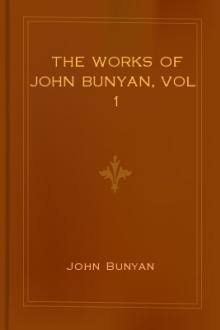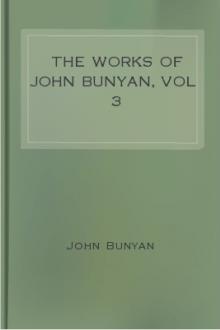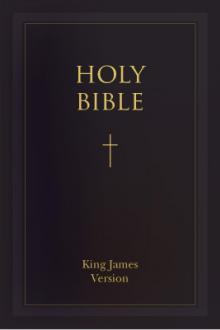The Works of John Bunyan, vol 1, John Bunyan [reading like a writer TXT] 📗

- Author: John Bunyan
- Performer: -
Book online «The Works of John Bunyan, vol 1, John Bunyan [reading like a writer TXT] 📗». Author John Bunyan
Why, God and his people; the people when they come to pray, and God when he is about to hear and give. ‘And the bow shall be in the cloud’; says God, ‘and I will look upon it, that I may remember the everlasting covenant between God and every living creature of all flesh that is upon the earth’ (Gen 9:16). And, I say, as the bow is for God to look on, so it is also for our sight to behold.
A rainbow round about the throne, in sight; in whose sight? in John’s and his companions, like unto an emerald.
We read of Solomon’s great throne of ivory, that though there was not its like in any kingdom, yet he was not willing that the bow of it should stand before him. It was round behind (1 Kings 10:18-20).
O! but God’s throne has the bow before, even round about to view, to look upon in sight. Solomon’s was but a shadow, and therefore fit to be put behind; but this is the sum and substance, and therefore fit to be before, in view, in sight, for God and his people to behold. Thus you see that a rainbow is round about the throne of grace, and what this rainbow is. Look then, when thou goest to prayer, for the throne; and that thou mayest not be deceived with a fancy, look for the rainbow too. The rainbow, that is, as I have said, the personal performances of Christ thy Saviour for thee. Look, I say, for that, it is his righteousness; the token of the everlastingness of the covenant of grace; the object of God’s delight, and must be the matter of the justification of thy person and performances before God. God looks at it, look thou at it, and at it only (Psa 71:16). For in heaven or earth, if that be cast away, there is nothing to be found that can please God, or justify thee. If it be said faith pleases God; I answer, faith is a relative grace; take then the relative away, which, as to justification, is this spangling robe, this rainbow, this righteousness of Christ, and faith dies, and becomes, as to what we now treat of, extinct and quenched as tow.
And a very fit emblem the rainbow is of the righteousness of Christ; and that in these particulars. 1. The rainbow is an effect of the sun that shines in the firmament; and the righteousness by which this throne of grace is encompassed, is the work of the Son of God. 2. The rainbow was a token that the wrath of God in sending the flood was appeased; this righteousness of Christ is that for the sake of which God forgiveth us all trespasses. 3. The rainbow was set in the cloud, that the sinful man might look thereon, and wax confident in common mercy; this righteousness is showed us in the word, that we may by it believe unto special mercy. 4. The bow is seen but now and then in the cloud; Christ’s righteousness is but here and there revealed in the Word. 5. The bow is seen commonly upon, or after rain; Christ’s righteousness is apprehended by faith upon, or soon after the apprehensions of wrath. 6. The bow is seen sometimes more, sometimes less; and so is this righteousness, even according to the degree or clearness of the sight of faith. 7.
The bow is of that nature, as to make whatever you shall look upon through it, to be of the same colour of itself, whether that thing be bush, or man, or beast; and the righteousness of Christ is that that makes sinners, when God looks upon them through it, to look beautiful, and acceptable in his sight, for we are made comely through his comeliness, and made accepted in the Beloved (Eze 16:14; Eph 1:6).
One word more of the rainbow, and then to some other things. As here you read that the rainbow is round about the throne; so if you read on even in the same place, you shall find the glorious effects thereof to be far more than all that I have said. But, Second. As the throne of grace is known by the rainbow that is round about it; so also thou shalt know it by this, the high priest is continually ministering before it; the high priest, or Christ as priest, is there before God in his high priest’s robes, making continual intercession for thy acceptance there. Now, as I said before, Christ is priest and throne and all; throne in one sense, priest in another; even as he was priest, and sacrifice, and altar too, when he became our reconciler to God.
As a priest here, he is put under the notion of an angel, of an angel that came and stood at the altar to offer incense for the church, all the time that the seven angels were to sound out with trumpets the alarm of God’s wrath against the antichristian world; lest that wrath should swallow them up also. ‘And,’ saith John, ‘another angel came and stood at the altar, having a golden censer; and there was given unto him much incense, that he should offer it with the prayers of all saint upon the golden altar which was before the throne. And the smoke of the incense which came with the prayers of the saints, ascended up before God out of the angel’s hand’ (Rev 8:1-4).
Here then you have before the throne, that is, the throne or mercyseat, the high priest; for there it was that God appointed that the altar of incense, or that to burn incense on, should be placed (Exo 30:1-7). This incense-altar in the type was to be overlaid with gold; but here the Holy Ghost implies, that it is all of gold. This throne then is the mercyseat, or throne of grace, to which we are bid to come; and, as you see, here is the angel, the high priest with his golden censer, and his incense, ready to wait upon us. For so the text implies, for he is there to offer his incense with the prayers of all saints that are waiting without at his time of offering incense within (Luke 1:10). So, then, at the throne of grace, or before it, stands the high priest of our propitiation, Christ Jesus, with his golden censer in his hand, full of incense, therewith to perfume the prayers of saints, that come thither for grace and mercy to help in time of need.[8] And he stands there, as you see, under the name of an angel, for he is the angel of God’s presence, and messenger of his covenant.
But now it is worth our considering, to take notice how, or in what method, the high priest under the law was to approach the incense-altar. When he came to make intercession for the saints before the throne, he was to go in thither to do this work in his robes and ornaments; not without them, lest he died. The principal of these ornaments were, ‘a breastplate, and an ephod, and a robe, and a broidered coat, a mitre, and a girdle’ (Exo 28:4). These are briefly called his garments, in Revelation the first, and in the general they show us, that he is clothed with righteousness, girded with truth and faithfulness, for that is the girdle of his reins to strengthen him (Isa 11:5). And that he beareth upon his heart the names of the children of Israel that are Israelites indeed; for as on Aaron’s breastplate was fixed the names of the twelve tribes of Israel, and he was to bear the weight of them by the strength of his shoulders, so are we on the heart of Christ (Isa 22:21).
Thus therefore is our high priest within the holiest to offer incense upon the golden altar of incense, that is, before the throne.
Wherefore, when thou goest thither, even to ‘the throne of grace,’
look for him, and be not content, though thou shouldst find God there, if thou findest him not there, I suppose now an impossibility, for edification’s sake, for without him nothing can be done; I say, without him as a priest. He is the throne, and without him as a throne, God has no resting-place as to us; he is a priest, and without him as such we can make no acceptable approach to God; for by him as priest our spiritual sacrifices are accepted (1 Peter 2:5). ‘By him, therefore, let us offer the sacrifice of praise to God continually,—giving thanks,’ and confessing to and ‘in his name’ (Heb 13:15). And for our further edification herein, let us consider, that as God has chosen and made him his throne of grace; so he has sworn, that he shall be accepted as a priest for ever there. For his natural qualifications we may speak something to them afterwards; in the meantime know, that there is no coming to God, upon pain of death without him.
Nor will it out of my mind, but that his wearing the rainbow upon his head doth somewhat belong to him as priest, his priestly vestments being for glory and beauty, as afore was said, compared to the colour of it (Rev 10:1; Eze 1). But why doth he wear the rainbow upon his head; but to show, that the sign, that the everlastingness of the covenant of grace is only to be found in him; that he wears it as a mitre or frontlet of gold, and can always plead it with acceptance to God, and for the subduing of the world and good of his people. But,
Thirdly, The throne of grace is to be known by the sacrifice that is presented there. The high priest was not to go into the holiest, nor come near the mercyseat; the which, as I have showed you, was a type of our throne of grace, ‘without blood.’ ‘But into the second went the high priest alone once every year, not without blood, which he offered for himself, and for the errors of the people’ (Heb 9:7). Yea, the priest was to take of the blood of his sacrifice, and sprinkle it seven times before the Lord, that is, before the mercyseat, or throne of grace; and was to put some of the blood upon the horns of the altar of incense before the Lord (Lev 4:5-7, 16:13-15). So then the throne of grace is known by the blood that is sprinkled thereon, and by the atonement that by it is made there. I told you before that before the throne of grace there is our high-priest; and now I tell you, there is his sacrifice too; his sacrifice which he there presenteth as amends for the sins of all such as have a right to come with boldness to the throne of grace. Hence, as I mentioned before, there is said to be in the midst of the throne, the same throne of which we have spoken before,





Comments (0)